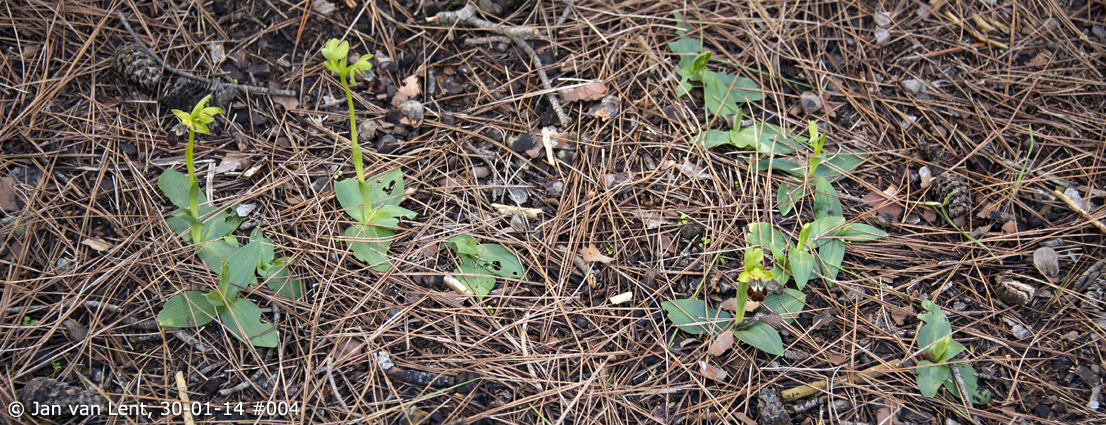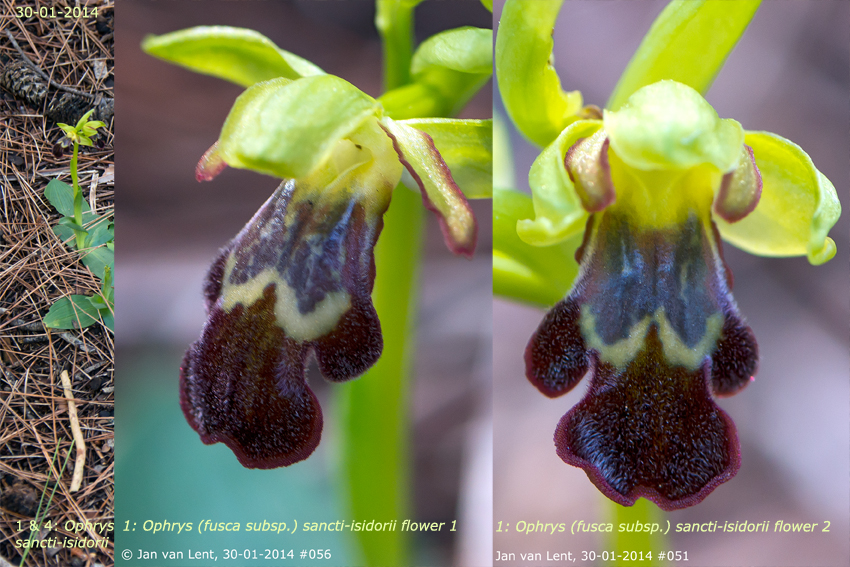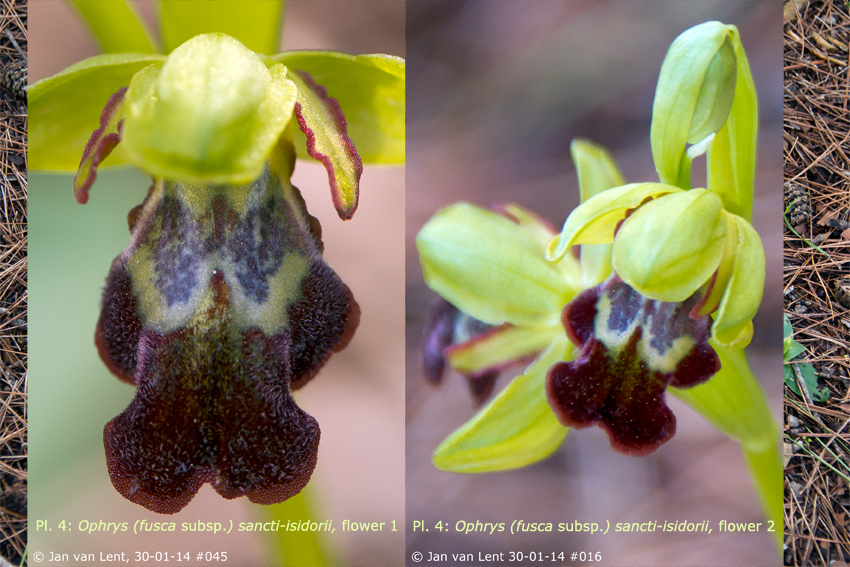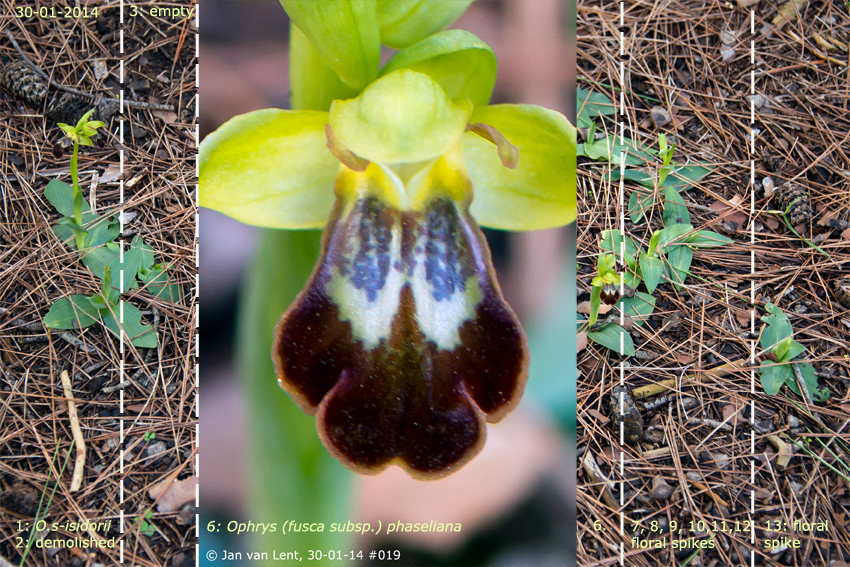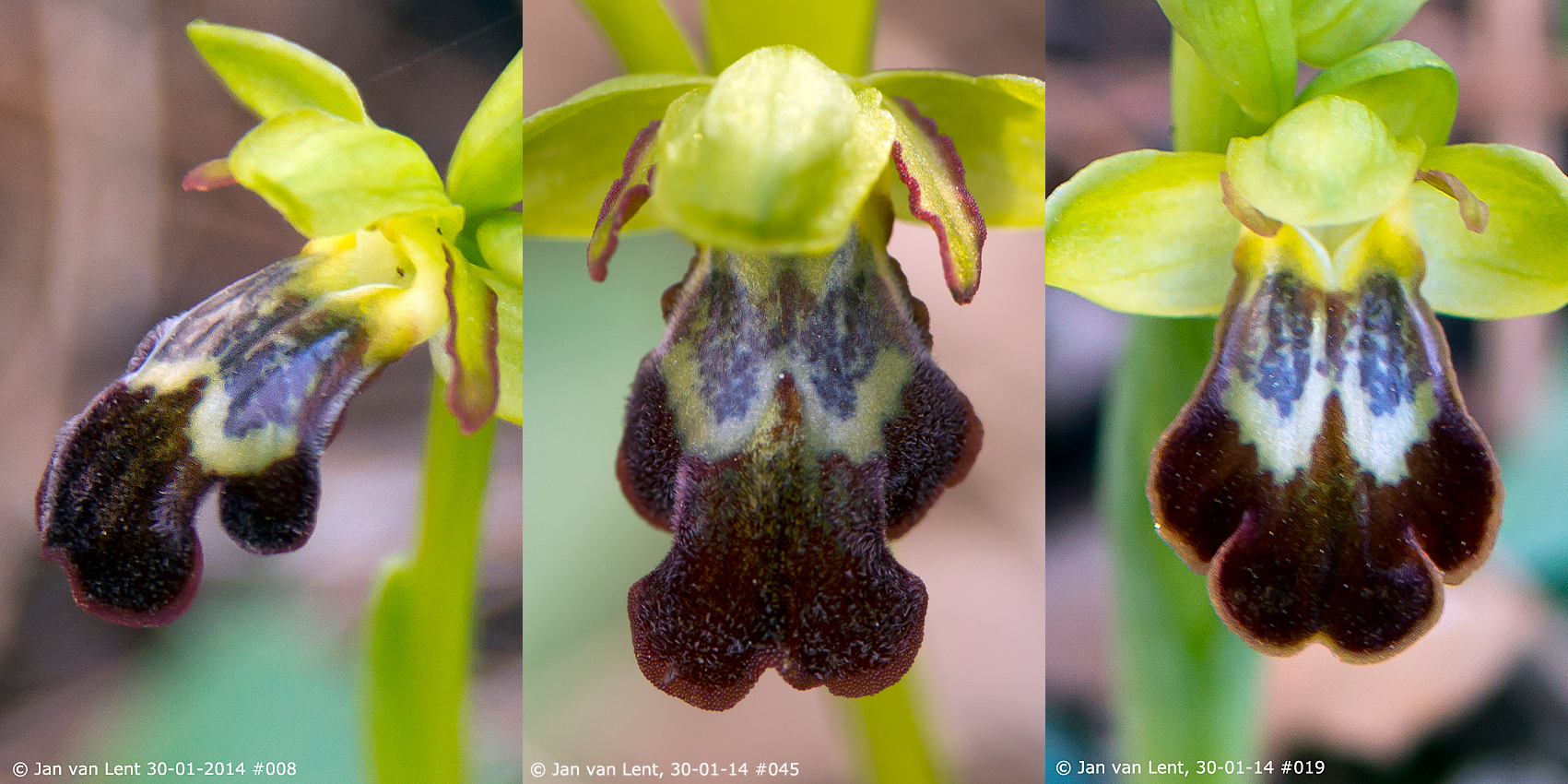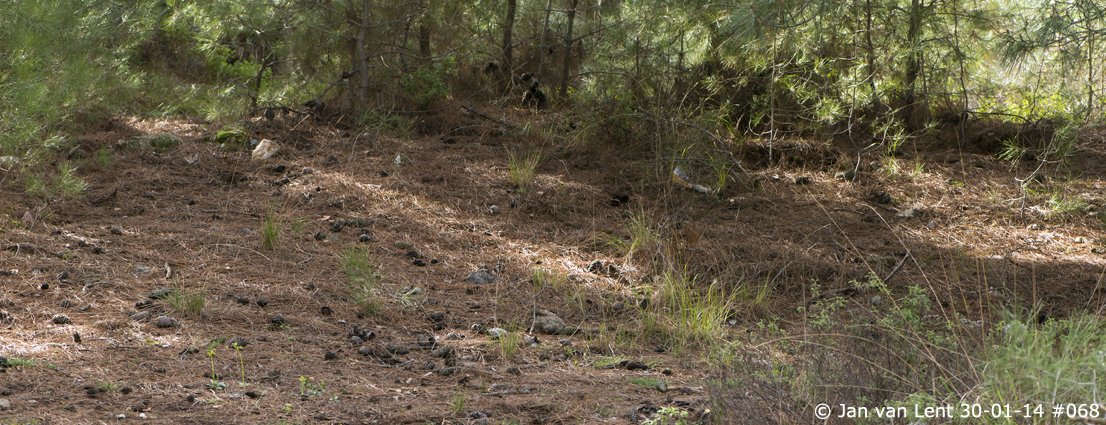Habitat: Lambou Mili parking, altitude 185m. Young pine woods.
Ophrys fusca group, Lambou Mili parking © Jan van Lent 30-01-14
The Ophrys fusca subsp. fusca group on this habitat:
23-01-2014: Ophrys (fusca subsp.) sancti-isidorii A. & P. SALIARIS & ALIBERTIS 2010,
30-01-2014: Ophrys (fusca subsp.) sancti-isidorii A. & P. SALIARIS & ALIBERTIS 2010,
Ophrys phaseliana D. & U. RÜCKBRODT 1996;
Ophrys (fusca subsp.) phaseliana (D. & U. RÜCKBRODT), KREUTZ 2004.
CONTINUATION from blog 30: The story of an ‘ordinary’ Ophrys fusca group, somewhere in a Lesvos pine forest along the ‘highway’ to Mytilini in the neighbourhood of Lambou Mili. Last week 2 Ophrys (nos 1 & 4) were flowering with only 1 flower each.
Plant 1 (left): Ophrys (fusca subsp.) sancti-isidorii. © Jan van Lent, 30-01-14 #056 & #051
PART 2: 1 week later (30-01-14) I stopped again on this parking space to see if anything had changed after the 4 days of rain last week and it had; number 6 was now also flowering. So now nos 1, 4 and 6 are flowering and no 1 & 4 are (still) Ophrys sancti-isidorii –each has now 2 flowers.
Plant 4 (left): Ophrys (fusca subsp.) sancti-isidorii. © Jan van Lent, 30-01-14 #045
Ophrys no 6 is more difficult to identify, it is certainly not Ophrys blitopertha although the rhomboidal form of the lip suggest otherwise, but after comparing this Ophrys with ‘the books’ I think it is the so called Ophrys (fusca subsp.) phaseliana.
Plant 6 (right): Ophrys (fusca subsp.) phaseliana © Jan van Lent, 30-01-14 #019 op #004.
RESEARCH: Ophrys (fusca subsp.) phaseliana, description PETROU ET ALL (2011): ‘A taxon with a broad distribution in the Aegean islands and Turkey. Lip not constricted nor kinked at its base, horizontal to pendant, broadly rhomboidal, tri-lobed and velvety, with narrow yellow border. Hairs grow in irregular tufts, so the lip looks spotted yellow and brown, but no so strongly patched as the lip of Ophrys (fusca or parosica subsp.) parosica; lateral lobes broad, rounded, often strongly curving backwards, occasionally under the median (lobe), which is a little longer, slightly bi-lobed. Speculum brown or blue with white spots, blotches or streaks … and is not bisected by a groove.’
Well, here we are!
But the doubt remains: the flowering time according to Petrou is mid March-April; we’re now in January/February. And also its habitat here in the pine woods is different: ‘In abandoned cultivation, phrygana, maquis and shrubland.’
According to ANTONOPOULOS (2009) it is not certain that Ophrys phaseliana is flowering in Greece: ‘Similar Ophrys (late plants with a flat lip and irregular colour pattern of the flower- Ophrys parosica) from the shores of Anatolia and south-western Turkey are classified as the separate species Ophrys phaseliana and, it is possible that the plants from the east Aegean are belonging to this latter species, or that these 2 taxa are synonyms.’ Well, this is certainly not Ophrys parosica because that Ophrys has a different form of the labellum and is much more ‘blotchy’.
But from those shores of Anatolia and south-western Turkey KREUTZ (1998) only featured Ophrys phaseliana, no parosica although some of his photographs (p476) showed clearly the (nowadays known) Ophrys parosica. His description and habitat: ‘Light pine forest, phrygana, bushes and street banks: on dry, moderate wet limestone soil.’ of Ophrys phaseliana also fits ‘my’ Ophrys phaseliana but its time of flowering is still the problem: ‘middle of April – beginning of May’.
On Rhodes & Karpathos (2002) and on Cyprus(2004) KREUTZ didn’t find any Ophrys phaseliana or Ophrys parosica.
Nor did KARATZÁS & KARATZÁ (2009?) on Lesvos. They described Ophrys parosica but – and that is very rare because they featured all taxa ever mentioned to flower on Lesvos – no Ophrys phaseliana.
BAUMANN ET AL (2006) described Ophrys fusca subsp. phaseliana from the Aegean (Crete, Karpathos, Rhodos, Cyclades, Samos and Lesvos) but their text and photograph (maybe Ophrys sitiaca?) have nothing to do with the above mentioned Ophrys phaseliana.
DELFORGE (2005) finally features – of course – all above mentioned Ophrys. But ‘his’ Ophrys phaseliana (photographs and flowering season) has also nothing to do with this Ophrys phaseliana from Lambou Mili.
3x Ophrys fusca subsp., pl.1, pl. 4, pl. 6. Lambou Mili parking © Jan van Lent 30-01-14
BOTTOM-LINE: Ergo, the problem with this Ophrys is that the only difference – with the two Ophrys sancti-isidorii next to it (distance 50 cm) – is the rhomboidal labellum, the form of the side lobes and the yellow/orange instead of red/light brown border. But people are murdered for less, so to speak. But it is also possible that it is just a hybrid between Oph. sancti-isidorii and one of the ‘upcoming’ Ophrys; maybe with Ophrys blitopertha, lindia or pelinaea? We will probably find out in the next episode of ‘sooner or later’…
Jan van Lent. 14-2-2014.
Ophrys fusca group, Lambou Mili parking © Jan van Lent 30-01-14 #068
Madonna: ‘Sooner or Later’ scene from “Dick Tracy”:
https://www.youtube.com/watch?v=piIH_6qLsNo.

